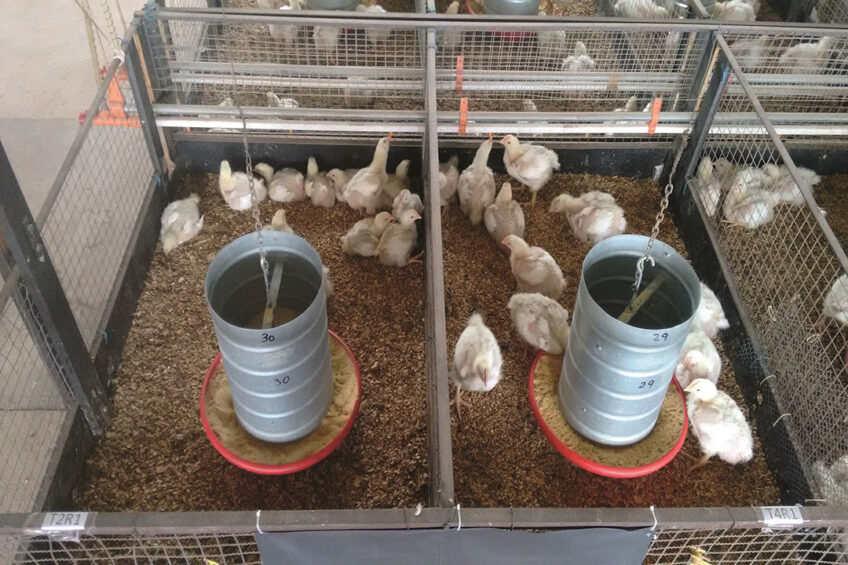Inflammation and immune activity cost energy

The gut is a highly complex ecosystem in which commensals and pathogens live in dynamic antagonistic interactions competing for the same niches and substrates. Any alterations in these relationships may lead to inflammatory reactions, gastrointestinal or systemic infections – in any event, to energy-consuming imbalances.
The intestinal tract is the largest immune organ with the most extensive contact surface between the environment and body. It comprises cells of the immune system as well as a huge number of microbes – the microbiota – which produce metabolites and vitamins. In homeostasis (or eubiosis), this system maintains host health by optimising beneficial symbiotic relationships. For the host it is necessary to prevent translocation of commensal and pathogenic micro-organisms across the mucosal barrier of the gut – that’s the mission of the gut immunity.
Figure 1 – Curves of weight development for the AGP supplemented group (PC) and the wood lignan supplemented group (NC + wood lignans) show the clear difference in performance development.

Microbial community impacts the performance of the bird
The gastrointestinal tract houses a dynamic and complex ecosystem. It is influenced by the microbial community, the composition and physical structure of the diet, as well as the age and health status of the bird. All these factors influence each other. Together they impact the health and performance of the animal. Bacterial colonisation of the GIT in chickens starts with hatching. First, the caeca are colonised by streptococci and enterobacteria. Within the first day of life, bacteria spread throughout the digestive tract. The composition of the intestinal flora changes with age. Bacterial density in the duodenum is low due to the short transit time, low pH and dilution by digestive juices. The environment for bacterial growth is more favourable in the jejunum. The greatest bacterial density is found in the caeca.
Beneficial effects of fermentable fibre
The small intestine is the site of enzymatical digestion. Proteins and carbohydrates that escape digestion in the small intestine are metabolised by the commensal microbiota in the hindgut. In general, fermentation of undigested carbohydrates (fermentable dietary fibre) is associated with beneficial effects: hindgut bacteria use fermentable fibre as an energy source and primarily produce short-chain fatty acids (SCFA) as metabolites. SCFA have favourable effects on the composition of the gut flora, help to prevent colonisation by pathogens, are absorbed by the bird and are used as an energy source, while butyrate is important for the health and integrity of the gut mucosa.
Protein fermentation
An excess of protein or an undersupply of fermentable feed components increases protein degradation by the gut flora of the hindgut. The composition of the intestinal flora shifts towards proteolytic bacteria. Protein fermentation produces ammonia and biogenic amines. Ammonia is a strong cytotoxin that damages the mucosa of the intestine and causes inflammation. It also passes easily into the bloodstream and stresses all organs. Protein fermentation is associated with inflammatory bowel disease in humans, with post-weaning diarrhoea in piglets and wet litter in poultry. Wet litter causes footpad dermatitis, hock burn and breast irritation in broilers. These symptoms lead to a decrease in performance and reduced usability of the carcass.
The intestinal tract and immune respone
The intestinal tract – even within its physiological range – is subject to constant irritation. Microbial contamination of the feed or drinking water, feed structure, feed composition – and the intestine reacts to all these factors with an immune response and inflammation. All these processes – regardless of the cause – represent an expenditure of energy.
Benefits of olive bioactives in gut health
For optimal animal performance and well-being it is essential to support intestinal health. Olive bioactives could be considered as an interesting tool to fight against gut disorders derived from stressful situations in poultry farming. Read more…
The subtherapeutic use of antibiotics as growth promoters (AGP) has been practised for decades to improve performance. AGPs not only have antimicrobial effects but also anti-inflammatory properties. The ban on AGPs opened up space for natural alternatives which also have the capacity to stabilise the intestinal flora and have anti-inflammatory effects.
Wood lignans as natural AGP alternative
A trial with a total of 416 male broilers (Cobb 500) compared the effects of a wood lignan product (agromed ROI) to either a negative control (NC) or a positive control (PC) with the commonly used AGP Virginiamycin in a corn/soybean diet. The wood lignans showed a significant positive influence on performance data in terms of weight gain, feed conversion, carcass and breast muscle percentage.
Positive effects were also recorded for some intestinal health parameters…
Positive effects were also recorded for some intestinal health parameters. Villus height in the ileum increased significantly in the lignan groups and consequently also the mucosal surface available for nutrient absorption. The lymphocyte count was reduced in the experimental groups, indicating a reduced need for immune defence and thus a healthier gut flora. This thesis was also supported by measurable changes in the intestinal flora: the pathogens (E. coli and Clostridium) in the faeces were reduced, while the growth of the desirable lactobacilli was promoted (sampling on day 21). The trial design and results are shown in table 1.
A closer look at the performance data shows a clear growth advantage in broilers supplemented with wood lignans compared to the positive control with Virginiamycin, especially from day 9 to day 22 (PC 660 grams body weight vs. NC + wood lignans 1003g body weight); afterwards the difference remained constant until the end of the fattening period on day 42.
Author:
Nina Neufeld, Neufeld GmbH













